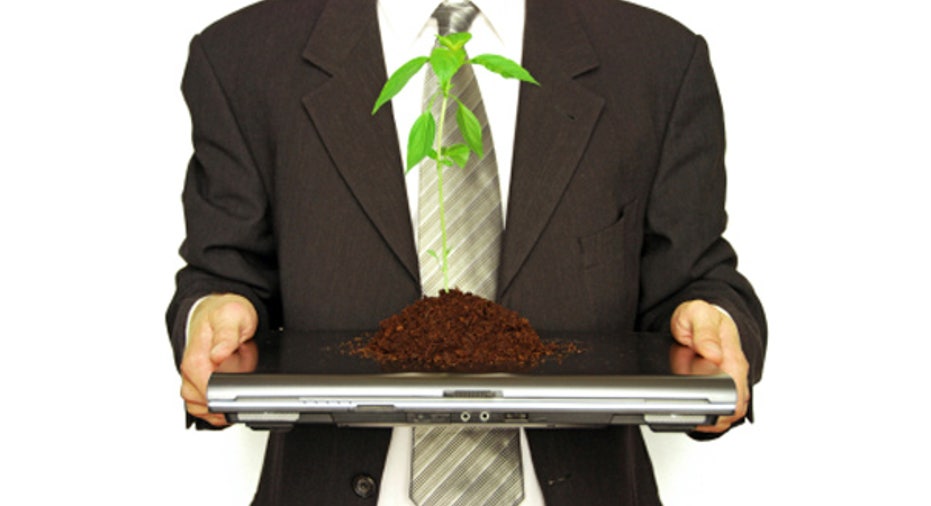Small Businesses Going Green: Now or Later?

Going green is more than just another trend for small business owners to jump on. It can be a major cost saver for owners over time, and improves productivity and marketability if done right, according to experts.
As the push for energy-efficiency becomes greater from Capitol Hill and beyond, the concept of greening for small businesses may no longer be a question of “if,” but “when.”
When Jim Bolger, owner of Earth FX in Maryhill, Ontario, moved his business to a new location in 2009, he stepped up the company’s commitment to greening in a big way. Earth FX is outfitted with LED lighting, geothermal energy, controls on heating and cooling and added solar panels on the roof. The switch cost the company $45 per square foot in the building, and according to Bolger, well worth it. Leaving the building in its previous state without any green products or practices would cost Earth FX up to 70% more on heat, air and light, Bolger said.
“It’s a statement on how we value environmental benefits, and it’s a quantifiable cost saver,” he said. “There are two fundamental ways to look at the challenge that lies ahead of us, and some ask, ‘what difference can I make?’ We decided from a corporate and personal perspective to do everything we can to improve our environment. We talk the talk and walk the walk.”
Randal Palach, president and CEO of NextEnergy in Detroit, said his company has seen firsthand the benefits of small businesses starting out green, rather than making the switch to green practices and products after the business is up and running. Although costs are absorbed from the start, Palach said over the course of a business’ life, the savings are even greater.
“If you look at it from a month-to-month cost, at times it may seem higher,” he said. “But the life cycle cost saves you money—it’s an ROI decision. Plus it adds value as a marketing opportunity with your green presence. The long-term numbers will show you it’s advantageous to go green right now.”
Green small business owners can take advantage of federal tax break incentives as well as state and local initiatives. There is a five-year payback until 2017 under a government stimulus program for energy and green investments. Moving to this model is not only an economic decision, but it can also improve the quality of life for employees, Palach said.
“If designed properly, you can improve indoor air quality, improve productivity by reducing sick days, and it adds to the ambiance of total comfort,” he said. “As a green business, you are more desirable.”
Author of “Greening Your Small Business,” Jennifer Kaplan, said when going green as a business, time is of the essence. Switching over later can will cost time and manpower, she said, and as all small business owners know, “time is money.”
“Starting out green is the way to go,” she said. “Then you can start out strategically, and it allows you to measure the ROI from the beginning.”
It’s important small business owners who are leasing space to realize that their power is greatest before signing on the dotted line. Asking for things like recycling, timers for lights and energy-efficient light bulbs should all take place before the deal is struck, Kaplan said.
Beginning a business with green practices shouldn’t cost an owner much more than starting out not green, she said. Small business owners can search out green office spaces to lease, and contact their electricity companies to request green energy. Going paperless, or putting a recycling program in place are simple, easy things small business owners can do right from the start.
Click here to learn more easy ways for small businesses to go green
“If you are looking to do higher-order greening things like installing solar panels, that will cost more and is in a whole different category of greening,” Kaplan said. “I always tell people to try ways to use less. It’s not eliminating, but using less.”
If a small business owner were to use heating and cooling controls, geothermal energy, tight windows, green design and planning, and solar insulation, Palach estimated there would be a 50% higher premium cost outright for owners. Payback will not be instantaneous or great at first, but over a life cycle the technology pays for itself, he said. On the flip side, retro-fitting green supplies on an older business could cost a small business up to 75% in premiums.
“If you look at productivity gains, savings over a lifecycle, the incentives are there,” Palach said.
Not only is the general public more interested in green products and practices today, Palach said, but people are starting to ask the right questions about making the switch to green in their home and work environments.
“People are starting to ask the right questions,” he said. “Five years ago, we would have to sell how the technology works and what it is. Now, consumers are coming in already informed.”



















